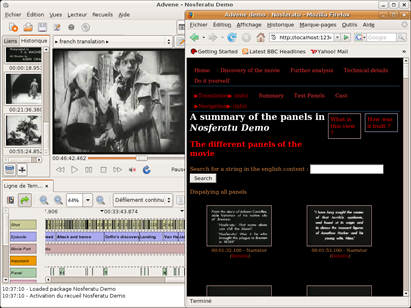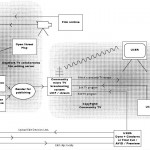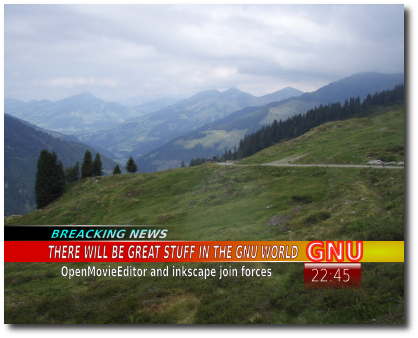
Advene (Annotate Digital Video, Exchange on the NEt) is an ongoing project in the LIRIS laboratory (UMR 5205 CNRS) at University Claude Bernard Lyon 1. It aims at providing a model and a format to share annotations about digital video documents (movies, courses, conferences…), as well as tools to edit and visualize the hypervideos generated from both the annotations and the audiovisual documents. Teachers, moviegoers, etc. can use them to exchange multimedia comments and analyses about video documents. The project also aims at studying the way that communities of users (teachers, moviegoers, students…) will use these self-publishing tools to share their audiovisual “readings”, and to envision new editing and viewing interfaces for interactive comment and analysis of audiovisual content.
View the examples to have an idea of the project’s potential
Visit Advene’s website
Comments (3) Posted on: Friday, July 18, 2008
by: copy.cult in category: Annotation tools


During the last week a small group of people have been working with Deptford.tv at Deckspace, Greenwhich on setting up a system for collaborative video. Building on the proposals by the Echo chamber project to connect Final Cut Pro’s output XML to Drupal, thought has been spent on creating a system involving the XML output of Cinelerra, based on this first draft -see below- made by Adnan. The aim is to produce at the end of next week a flowchart that maps the process, and from which possible optimisations of the system can be derived before the next Deptford.tv workshop will take place in october. The database of Deptford.tv is excellent case study material for trying to set up such a system.

The above sketch shows a connection from the Deptford database to a version of the Bitnik Copyfight broadcasting system, indicated by the blue cloud on the right, and described on the site of Bitnik. A possibility for the future, but not the center of this workshop.


Lisa Haskel installed a SVN versioning system, which can be used by editors to exchange cinelerra output xml files. Meaning off course that all editors will have to work with Cinelerra, which I find excellent and exciting news. One way of permitting editors to opt working with Final Cut Pro could be to write a script that translates between the two software’s differently formatted project XML’s. SVN adds a particular potential to the project: Forking, making versions of the same project accessible and editable opens new avenues for a symphonic collaborative video project.
The work will continue next week, further reports of developments will follow.
Comments (1) Posted on: Monday, July 7, 2008
by: Peter in category: Collaborative filming, News

Alexander Grundner is a San Francisco Peninsula based web publisher who likes to play with Linux in his free time. He posts some tips on transcoding video on his blog that might be helpfull for all you Cinelerra lovers.
Thanks Doma
Comments Off on Tips for Transcoding Cinelerra Compatible Video with FFmpeg, MEncoder Posted on: Sunday, July 6, 2008
by: Peter in category: Editing software, Manuals, Problems and solutions


OpenCut claims to be a ‘completely open-source’ film competition designed to encourage people to take professionally shot material and edit it in their own way. It is organised by the Red company, producers of camera systems, and in that light we should understand that the true goal of the contest is to advertise their products.
As there is no “one way” to tell a story, so too can stories benefit from being re-edited and re-told from many different vantage points and perspectives.
The winner of OpenCut 1.0 will receive a brand new AJA IO HD from Silverado. They will also be recognized as the “editor-of-record” at IMDB and will have their cut submitted to multiple film festivals.
Participants can obtain rushes by sending in their harddrives which will loaded and send back. The script can be found online, next to lists of requirements and the rules of the game
Since this is a corporate undertaking it is understandable that it pushes requirements that are inline with the quality of the source material. But advising participants to use Mac, FCP and h.264 can hardly be called open source.
It is a shame that such a nice initiative does not go further in supporting their claims to be completely open. Right now open seems to mean: ‘you can remix our material, as long as you do not use it for commercial purposes’. Red will use the uploaded cuts to showcase teir products. It would be appreciated if the Red company would put its money money where its mouth is, step up and start actively supporting open source film production.
How? A few suggestions for a next round:
* Invest in formulating specifications of a true open source workflow involving open source edit solutions (codecs, software)
* Open the hardware specifications of Red camera’s, call for proposals to bend, change, alter, improve, abuse existing technology.
* Give support to help develop open codecs up to industry standard.
The first call for the film Susannah has been closed, some of the results can be seen on Vuze.
Comments (1) by: OSVideo in category: Collaborative filming, News

Big Buck Bunny is a new film produced by the Blender foundation, makers of The Elephants Dream. Big Buck Bunny is a funny little showcase of what Blender is capable of: rolling 3D eyeballs, an über realistic 3D spacious layout, high definition detailed imaging, flying camera pans … an enjoyable film although a bit manieristic in its effects and pretentious in its Wagnerian soundtrack: anyway, worth checking out if you want to learn how pestering turns even the sweetest bunny into a revenging jungle warrior. Many different file types and sizes can be found on the download page.
The film is under a Creative commons attribution share alike license, we’re looking much forward to the forthcoming mesh ups. It is made entirely with open source tools of which besides Gimp and Inkscape the most important is of course Blender. Rumor goes that for the next film the whole team will be female, to balance out the obvious gender inequality from which the current production crew is suffering.
Comments Off on Big Buck Bunny Posted on: Saturday, July 5, 2008
by: OSVideo in category: Films and Projects, News
( From blog.wired.com )
Google will have to turn over every record of every video watched by
YouTube users, including users’ names and IP addresses, to Viacom, which
is suing Google for allowing clips of its copyright videos to appear on
YouTube, a judge ruled Wednesday.
Viacom wants the data to prove that infringing material is more popular
than user-created videos, which could be used to increase Google’s
liability if it is found guilty of contributory infringement.
[…]
Comments Off on Judge Orders YouTube to Give All User Histories to Viacom Posted on: Friday, July 4, 2008
by: OSVideo in category: Copyrights and licenses, News

Check out the (relatively) new blog: Open Movie Editor News by Open Video enthousiast and developer of the open source video-editor Open Movie Editor Richard Spindler.
Open Movie Editor is a video-editing software for Linux which can be downloaded here
Some nifty tips and articles on the blog; among others Richard has been fiddling with making titles for video in the popular drawing soft Inkscape, you can download SVG files of tests he made, open the files in Inkscape, adapt to your taste. Quite useful if you don’t want to start from scratch.
More later on the editing software itself, looking forward to giving it a good test.
Comments Off on Open Movie Editor blog Posted on: Wednesday, June 18, 2008
by: Peter in category: Editing software, Manuals, News

A new initiative on the Open Source Non Linear Editing video block: Lumiera started out as Cinelerra 3, a complete code rewrite of Cinelerra, but is now turning into an independent project.
On the still very incomplete Lumiera.org website you can share your ideas on the GUI with the developers.
As an introduction you can find information on a pipawiki page.
Design documentation can be found in a TiddlyWiki.
You can browse the code repository with webgit.
For the structure of the code look at the Doxygen documentation
More coming soon
Comments Off on Lumiera first steps Posted on: Sunday, June 15, 2008
by: Peter in category: Editing software, News

Committed to sharing her music via the net, Kristin Hersh is throwing her muses at us in unconventional ways. In this small manifesto she writes:
I think I need to engage in a grassroots kind of capitalism, choosing principles over profits, values over image, ideals over marketing. I have to create a permeable membrane between artist and listener — I’m a craftsperson, after all. (…) This little business will be interactive and intelligent; you will not be lied to, no shiny poison, no middle man.
Kristins work is featured on the website CASHmusic.org. Cash is ‘a Coalition of Artists and Stake Holders building an open-source platform for the new, distributed music business.’
[…]
Comments Off on The pearls you cast before swine make you seem alive by: Peter in category: Copyrights and licenses, Media archives
Stray Cinema is an open content filmproject. The idea behind it is that people from all over the world can download and re-edit raw footage, they make different films using the same footage. The films are then uploaded and voted on by the community. Stray Cinema organises ‘real world’ screenings of the top five films. The first one will take place in New Zealand on the 23rd of September 2008.
[…]
Comments Off on Stray Cinema Posted on: Sunday, June 1, 2008
by: OSVideo in category: Collaborative filming, News









Recent Comments